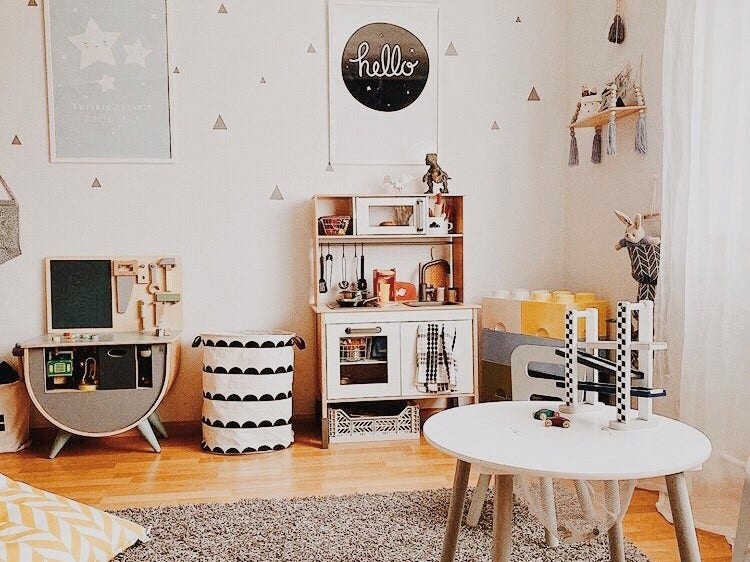You hear the clatter of tons of toys being dumped out of a box, followed by “Mama! Mama! MAMAAA!,” and finally the patter of little feet coming to find you. Sound familiar? While toddlers do need plenty of play time with parents and other caregivers (and no complaints here because those cuddles and giggles are life), independent play is also an important skill for your toddler to develop. We can set them up for success by providing a toddler-friendly play space that meets them where they’re at developmentally, but with so many differing opinions about what’s best for kids, doing that is easier said than done! We’re here to cut through the confusion with three super simple tips you can implement to set up the perfect playroom for your toddler.
Stock quality toys and activities
First, let’s tackle the types of toys you keep in your toddler’s playroom. According to the official Toy Buying Tips for Babies & Young Children from the American Academy of Pediatrics, simple is often best. They break down their recommendations into the following categories:
Symbolic and pretend play
Simple toys that encourage dramatic play are perfect for encouraging growing imaginations. These don’t have to be elaborate, fantasy-based toys. Toys that mimic everyday objects and activities are great for toddlers. The AAP recommends things like “toy characters (such as dolls, animals, and action figures) and toy objects (like food, utensils, cars, planes, and buildings)”. Simple play kitchens and kitchen accessories, baby dolls, dollhouses, and playsets based on real-life all fit the bill.
Fine motor/ adaptive/ manipulative
The AAP recommends “‘traditional favorites’ (like blocks, shapes, puzzles, and trains)” to help your toddler develop their fine motor skills, problem solving skills, and language and brain development.
Art
Again, simple works. An art space with a few basics like crayons, stickers, and coloring books, is a great starting point for toddlers.
Language / concepts
Books are one of the best language-developing tools you can give your child, and they definitely deserve a spot in your playroom!
Gross motor / physical
It’s no secret that toddlers crave challenging ways to move. Balls, climbers, push wagons, pull toys, and riding toys will help your toddler get enough physical activity and develop their gross motor skills. As far as what not to buy, the AAP cautions against toys that are built to replace human interaction (such books that read for you), excessive screen time, and too many “sensory-stimulating noise and light toys.” They also encourage giving kids a wide variety of toys to avoid gender stereotypes – remember that play kitchens and dolls aren’t just for girls, and action figures and trains aren’t just for boys.
Display toys and books at your toddler’s level
Now, how do you actually get them to play with those perfect toys? First, make sure your toddler can actually see and reach them easily. Closed off storage and high shelves are not your friend here. Whenever possible, go for low, open shelves and open displays. Forward-facing bookshelves are perfect for toddlers because they allow them to see the covers as they choose a book.
Don’t overwhelm them with choices
We can’t talk about displaying toys without talking about how many toys you display. Toddlers are easily overwhelmed by clutter, so providing just a few options at a time will help them focus and play for longer. Keep out 1-3 toys from each of the categories above, and put the rest away in a closet. Then, rotate toys in and out of the playroom to keep your toddler’s interest. We also love the Montessori-inspired principle of displaying each toy separately. For open shelves, make sure there’s plenty of space between each toy, and for open bins and cubes shelves, only display one toy or activity per unit bin / cube.
These three simple principles – quality toys; low, open displays; minimal clutter – work whether toddler’s play space is in the living room, their bedroom, or a dedicated playroom. You’ll have a toddler-friendly space to encourage plenty of play and reading time together and gradually more and more independent play (hallelujah!).
